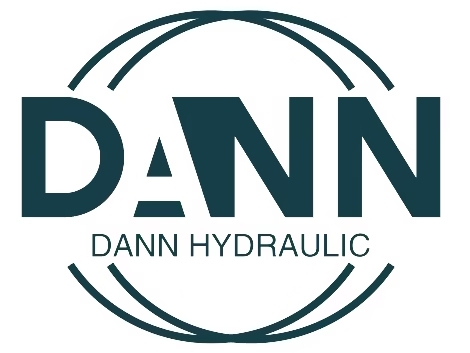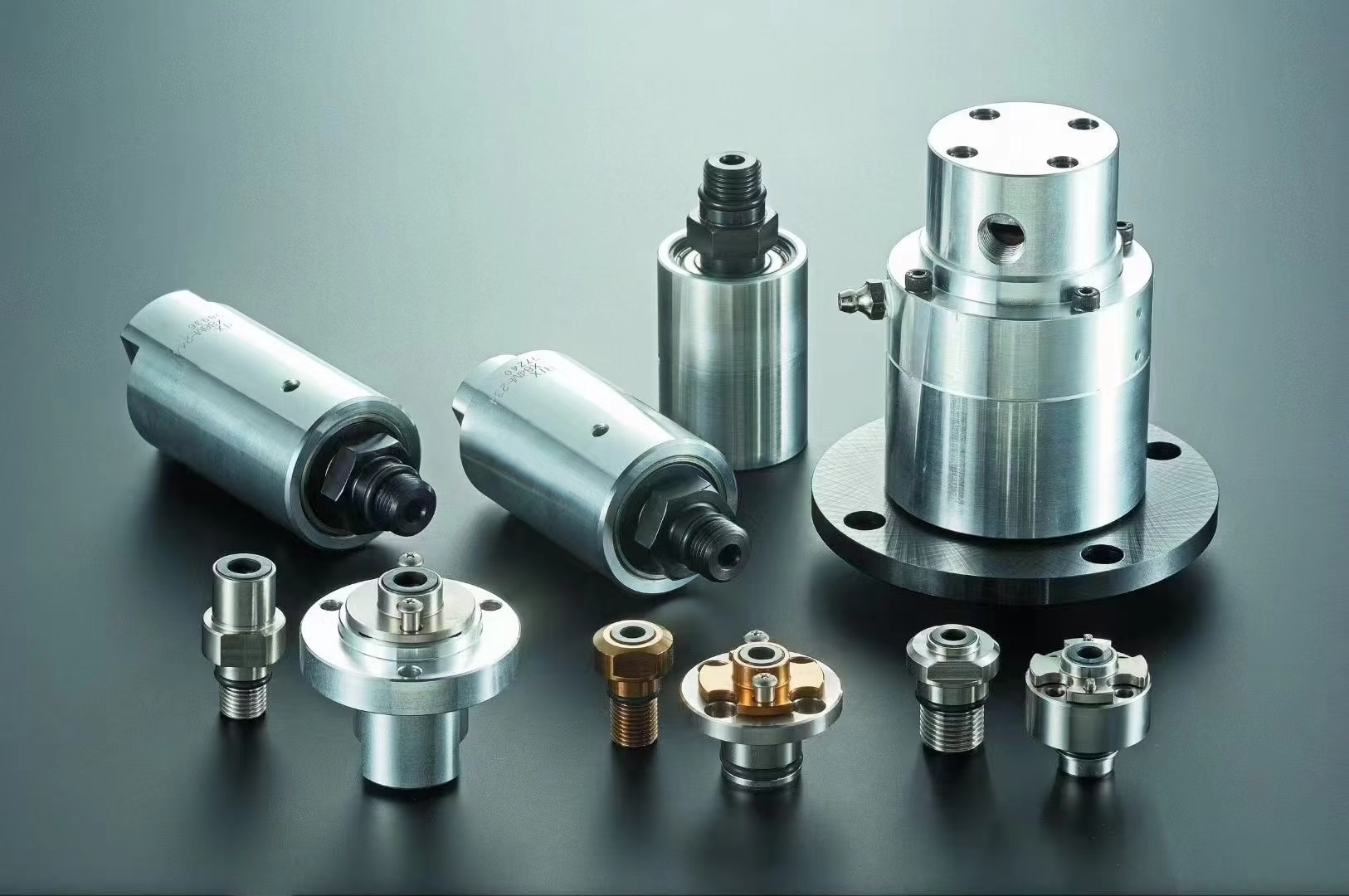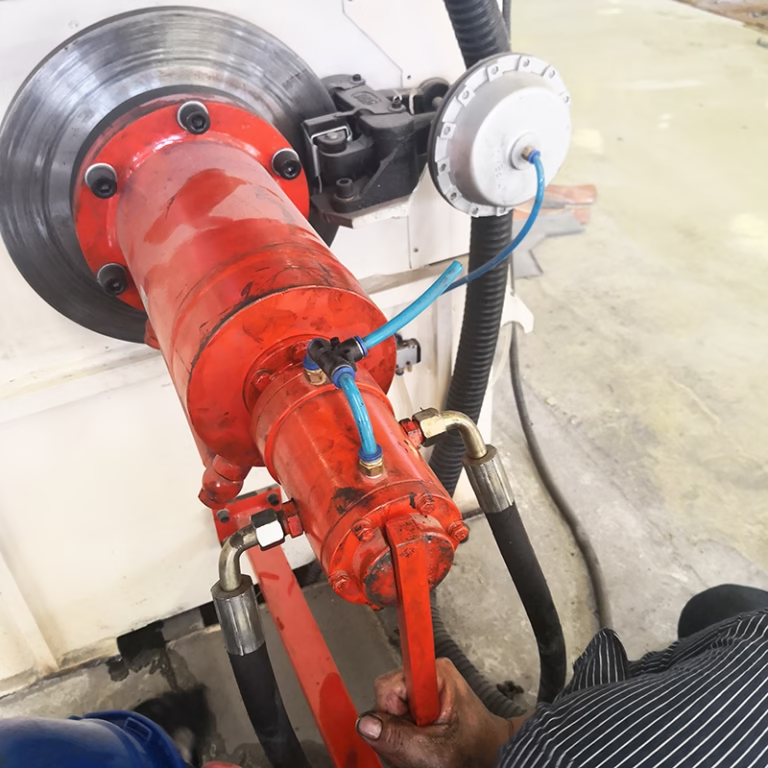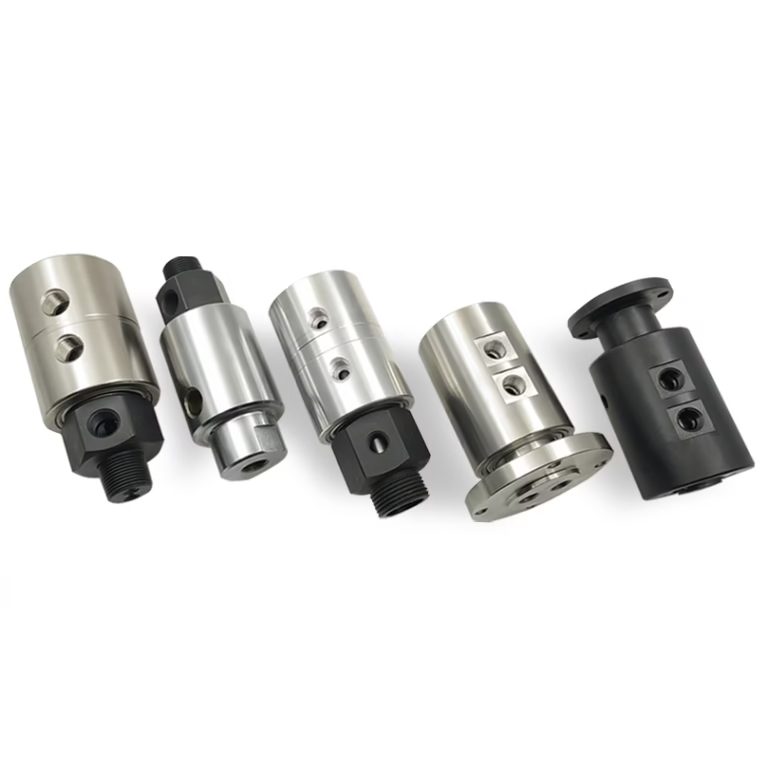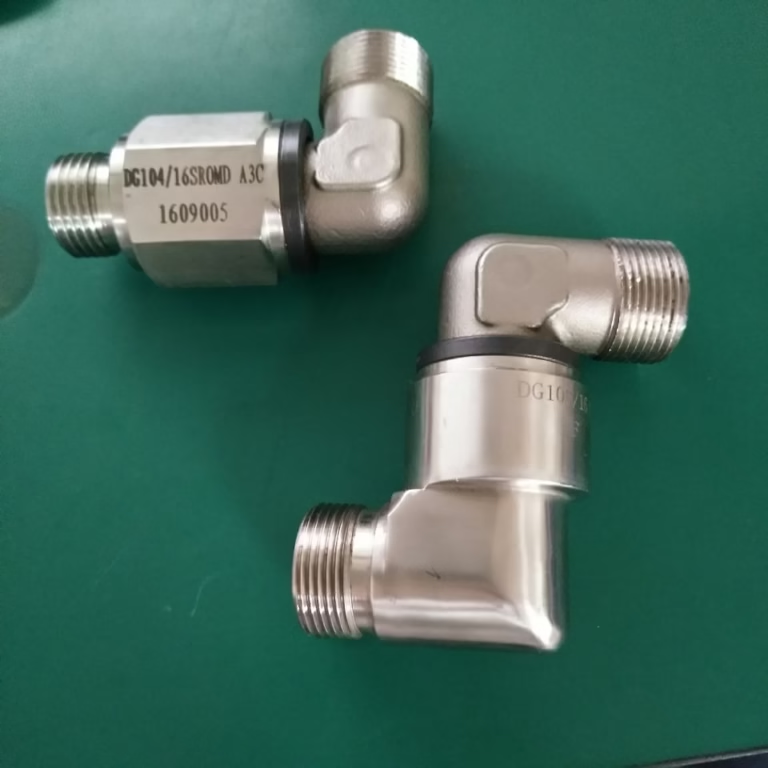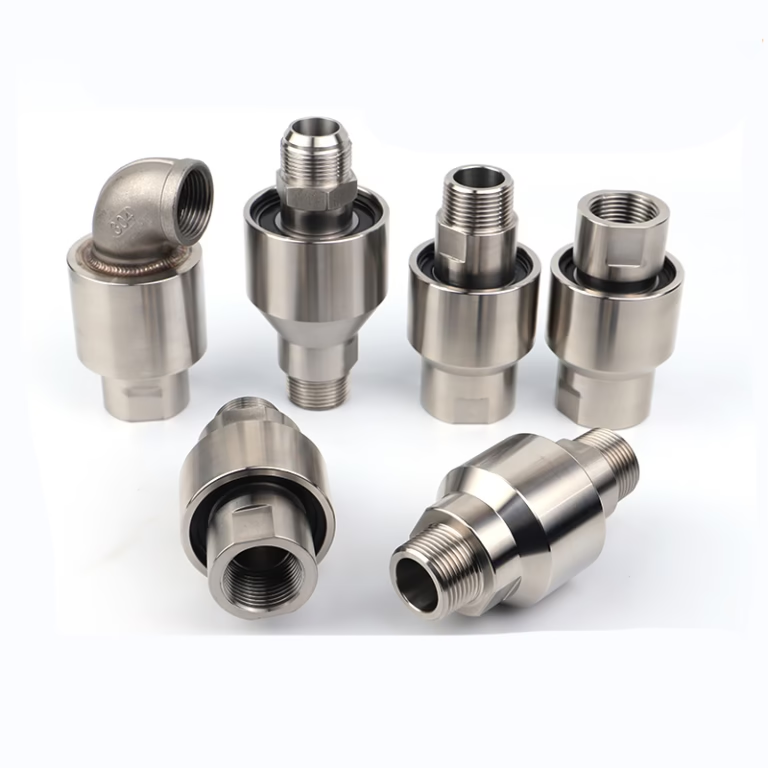Working Principle & Technical Analysis of RIX Rotary Joint in Semiconductor Industry
RIX rotary joints are crucial precision devices for fluid transmission in semiconductor manufacturing. Their core function is to achieve leak-free medium transmission between rotating parts and fixed pipes, especially in key processes such as chemical mechanical polishing (CMP) and wafer cleaning.
In semiconductor manufacturing, rotary unions (rotary joints) are critical fluid-transfer components that deliver cooling water, process gases, vacuum lines, or other media between stationary supplies and rotating parts of equipment. For example, wafer processing tools like CVD reactors, etchers, spin coaters, and grinders all require continuous fluid or vacuum connections to rotating spindles, chucks, or chambers. A rotary union allows fluids to pass from a stationary inlet to a rotating outlet while maintaining a seal. In wafer fabs, tight cleanroom and ultra-clean vacuum conditions demand rotary joints that generate virtually no particles, prevent leaks, and withstand high speeds and aggressive chemistries. RIX Corporation (Japan) – known for its “Rocky” rotary joint brand – supplies high-precision rotary unions tailored for semiconductor manufacturing equipment.
This article examines the working principle of RIX rotary joints, their design features (seals, materials, vacuum capability), applications in wafer processing tools, and how they compare to other rotary union technologies. We also discuss the benefits of RIX joints (including equipment longevity, leak prevention, and speed) and key selection criteria that procurement engineers should consider when specifying RIX rotary unions for fab tools.
Working principle of the RIX rotary joint in the semiconductor industry
The basic principle of any rotary union is similar: stationary media enters the housing and flows through a sealed interface to the rotating rotor, then exits through a rotating port. What sets RIX apart is its sealing mechanism. Traditional unions use contacting mechanical seal faces (often tungsten-carbide against carbon/ceramic) that rotate against each other to maintain a seal. Over time, these contacting seals wear down, increasing leakage. RIX’s advanced designs minimize or eliminate this contact. For example, RIX’s clearance seal (MFC) type uses a microscopic gap (clearance) between rotor and stator rings. Fluid forms a thin film that effectively seals against leakage without physical contact.
In effect, RIX creates a “non-contact seal” – the fluid dynamics of the narrow gap prevent cross-leakage, while the rotor still turns freely. The RIX MFC (Magnetic Fluid Coupling) clearance seal thus has no wear surfaces – “there is no seal lifetime because this is a non-contact seal type”.
Inside a RIX rotary joint, pressurized fluid (water, air, oil, or vacuum) enters through static channels in the housing and flows into passages in the rotor. Bearings support the rotor for high-speed rotation, while the specially machined stator-rotor interface (clearance seal) holds pressure. Because the seal faces never rub, there is effectively zero mechanical seal wear. This eliminates the need for frequent seal replacement and yields minimal heat generation. RIX typically incorporates multiple bearing configurations (ball bearings, bushings, or even bearing-less designs) to achieve high precision. Some RIX series (bearing-less type) rely on fluid film bearings or magnetic couplings for ultra-high-speed, ultra-clean operation.
1. Fluid transmission mechanism
RIX rotary joints use internal sealing structures to transmit fluids from fixed sources (such as pumps) to rotating parts (such as CMP polishing heads). When the device rotates, the internal rotating parts move synchronously with the spindle, while the outer shell remains stationary. Seals (such as O-rings or gap seals) maintain close contact between the dynamic ring and the static ring through spring preload or fluid pressure to prevent leakage.
2. Non-metallic material design
In response to the strict control of metal ion contamination in the semiconductor industry, the main circuit of the RIX rotary joint uses non-metallic materials (such as PEEK, PTFE) or coating treatment to minimize the dissolution of metal ions into the fluid. For example, the MFES series multi-channel rotary joint controls the amount of metal ion dissolution at an extremely low level through the non-metallic main channel design, meeting the transmission requirements of ultrapure water or chemical liquid.
3. Multi-channel and composite fluid support
Some models (such as the MFES series) support the simultaneous transmission of pure water, vacuum, air, and other fluids to meet complex process requirements. For example, in CMP equipment, the rotary joint needs to supply grinding liquid, coolant, and discharge waste liquid at the same time. The multi-channel design can simplify the pipeline layout and improve the integration of equipment.
In summary, a RIX rotary joint operates by routing media through its body to rotating outlets, using either clearance seals (for minimal wear) or advanced contact seals. Fluid enters at the center or rear, passes through a sealed labyrinth, and exits via rotating ports. Because semiconductor processes demand leak-tight UHV or clean gas environments, RIX often uses metal components (stainless steel, copper alloys) and non-lubricated seals to meet these needs. The result is a high-precision rotary union that can handle vacuum, high pressure, and high speed simultaneously – a necessity for modern fabs.
Core technology advantages
1. High-precision sealing technology
Gap sealing
Sealing is achieved through extremely small gaps (micrometer level), reducing friction loss, and is suitable for high-speed rotation scenarios (such as the maximum speed of the MFES series is 200rpm).
Elastic compensation mechanism
Built-in springs or bellows compensate for the wear of the sealing surface to ensure the stability of the sealing performance under long-term use.
2. Corrosion and wear resistance
The parts in contact with the fluid are made of corrosion-resistant materials (such as Hastelloy and ceramics), which can withstand the erosion of acid and alkali chemical liquids and extend the service life.
3. Low particle generation design
The sealing surface finish is below Ra0.2μm, which reduces the particle contamination caused by friction and meets the cleanliness requirements of semiconductor manufacturing.
Comparative Analysis: RIX vs Other Rotary Unions
How do RIX rotary joints stack up against other industry options? The main alternatives include mechanical-seal unions (e.g., Deublin, DSTI) and specialized vacuum feedthroughs (e.g., ferrofluidic unions by Moog GAT).
Key points of comparison:
Sealing Technology
Most conventional unions (Deublin, DSTI, Rotoflux) use contacting mechanical seals. These seals (often ceramic-to-graphite or tungsten-carbide faces) create a robust seal, but wear over time. As Duff-Norton notes, “leakage of rotating unions will increase over time as the contacting seals wear”. RIX’s clearance seal avoids this: with essentially no face contact, there is no gradual wearing. In practice, this means a RIX joint will maintain its original leak-tightness far longer than a contact-seal union.
Speed Limits
Some conventional water or oil unions can reach very high speeds (10,000–15,000 RPM) by virtue of advanced bearings and balanced seals. For example, Deublin’s high-speed water unions use balanced tungsten-carbide seals. RIX joints (particularly bearing-less types) are also high-speed, but the common MFC units are rated ~3000 RPM. In many semiconductor tools, rotational speeds are below a few thousand RPM, so RIX’s range is sufficient. For extremely high RPM (as in some spindles), mechanical unions or specialty joints might edge out RIX in raw speed.
Leak Performance
RIX’s design gives inherently low leakage (only clearance-gap diffusion), whereas mechanical seals have a small working leakage by design (though typically very low with precision machining). Ferrofluidic rotary feedthroughs (Moog) achieve essentially zero leak even in UHV (10^–9 torr), but they’re costly and usually single-channel. RIX unions can achieve very low leak rates and are better suited for multi-channel fluid service. Also, RIX uses double-drain and double-seal structures in certain series (e.g., LX84V/86V) to protect bearings from contamination, further reducing the risk of internal leaks reaching bearing surfaces.
Maintenance and Life
Conventional unions require periodic maintenance to replace seal faces or re-lubricate; downtime is a concern. RIX’s wear-free seals mean maintenance is typically only for bearing wear or general checks, not seal replacement. This translates to longer equipment uptime.
Media and Ports
Both RIX and others offer multi-passage versions. RIX’s MF (multi-flow coupling) series can have 3+ ports, custom-built. Deublin and DSTI also offer multi-channel unions, but RIX’s advantage is customization – they will design based on the exact fluid specifications required. In terms of media, RIX covers air, water, oil, and vacuum. Some competitors offer unique models (e.g., DSTI’s specialized chlorine-resistant seals or Rotoflux for pneumatic lines), but RIX’s product breadth is wide.
Cleanroom/UHV
In ultra-clean or UHV applications, ferrofluidic or magnetically-coupled feedthroughs are sometimes preferred. RIX doesn’t explicitly advertise “ultra-high vacuum” feedthroughs, but their vacuum-rated unions and clean materials can meet many high-vacuum needs. If ISO-class 1–3 environments are needed, RIX’s stainless and copper constructions, plus its non-lubricated operation, make it very competitive. Pfeiffer Vacuum notes that vacuum systems in semicon must meet stringent cleanroom standards; RIX’s design is inherently conducive to such standards.
Cost and Availability
RIX rotary joints tend to be custom-made per application, which can make the upfront cost higher than off-the-shelf unions. However, the long-term savings (less downtime, longer life) often justify the investment. Major brands like Deublin and DSTI might have shorter lead times for standard sizes. RIX does have a global presence (Japan HQ, plus RIX North America distribution) to support customers worldwide.
Typical application scenarios of the RIX rotary joint in the semiconductor industry
1. Chemical mechanical polishing (CMP) equipment
Function: Supply grinding fluid to the rotating polishing head and discharge waste fluid at the same time.
Technical requirements: It needs to withstand high speed (usually >100rpm) and the corrosiveness of the grinding fluid to ensure stable fluid pressure (0.1~0.6MPa).
RIX solution: The MF series rotary joint adopts a non-metallic main circuit and combines gap sealing technology to achieve leak-free transmission.
2. Wafer cleaning process
Function: Transmit pure water or chemical liquid (such as SC-1, SC-2 cleaning liquid) to the rotating cleaning brush head.
Technical requirements: It needs to support high-frequency start and stop (such as single-wafer cleaning equipment) and fast liquid discharge to avoid cross-contamination.
RIX solution: The MFC series rotary joint uses a multi-channel design to achieve fast switching between cleaning liquid and dry gas.
3. Electrochemical Deposition (ECD) and Atomic Layer Deposition (ALD)
Function: To transmit coolant or reaction gas during the deposition process and maintain process temperature stability (e.g., ALD needs to control temperature fluctuations <±1°C).
RIX Solution: L40 series rotary joints use low thermal expansion coefficient materials to reduce the impact of thermal deformation on sealing performance.
Selection Criteria for Procurement Engineers
When evaluating RIX rotary joints for semiconductor manufacturing equipment, procurement and engineering teams should consider the following:
Media and Pressure Requirements
Specify all fluids (coolant, vacuum, oils, gases) that will flow through the union, along with their pressure ranges. RIX needs this to choose the correct seal design. For example, coolant lines (water/DIW) at <1 MPa, or gas purge lines, or vacuum lines to –0.1 MPa. If UHV is needed, confirm RIX can meet that level (often 10^-5 to 10^-6 torr is achievable with proper design).
Rotational Speed
Determine the maximum RPM and whether the tool requires bidirectional rotation or oscillation. RIX rotary unions have published speed limits (e.g., 3000 RPM for clearance types); ensure the chosen model covers your spindle speed.
Number of Passages/Ports
Many wafer tools combine circuits (e.g., coolant + oil + air). Outline how many separate channels are needed and their functions. RIX can provide multi-channel (MF type) rotary joints tailored to the exact number and sizes of ports.
Environmental Compatibility
Since semiconductor fabs are stringent, ensure materials and certifications match. RIX products should be confirmed for cleanroom use (ISO Class spec) and for any chemical compatibility (e.g., FR-4, FR-5, or aggressive chemistries). RIX’s corrosion-resistant materials are generally suitable, but get confirmation.
Maintenance and Service
Discuss expected maintenance intervals. RIX’s no-wear seals mean less downtime, but bearings may need periodic replacement in extremely high-duty cases. Check with RIX on recommended inspections. Also, ensure good support and local service; RIX has a network (e.g., RIX North America) to provide technical assistance and spare parts.
Brand and Quality
As one procurement guide emphasizes, choose brands with proven quality and service. RIX’s century-long history and adoption by leading machine tool makers a strong indicators of reliability. Request performance data (leak rate, lifetime, particle counts) and customer references if needed.
Cost & Lead Time
Balance cost against the value of reliability. A slightly higher upfront cost for an RIX joint that lasts longer and avoids downtime can be justified by overall productivity gains. Also consider lead times – customized joints may take longer to produce, so plan for procurement lead time.
Regulatory Compliance
Ensure the chosen rotary joint meets any industry standards (RoHS, REACH, etc.) and consider cleanliness certifications (e.g., class in a nitrogen purge system). RIX, as a global manufacturer, typically adheres to relevant standards.
In short, procurement engineers should treat the rotary joint as a critical component, specifying all technical parameters up front and selecting a vendor (like RIX Corporation) known for high-quality, industry-specific solutions.
Conclusion
RIX Corporation’s rotary joints bring a distinctive combination of reliability, precision, and cleanliness to semiconductor manufacturing. By using innovative sealing designs (especially non-contact clearance seals), robust materials, and tailored multi-channel construction, RIX rotary unions meet the demanding requirements of wafer processing equipment. These joints keep cooling water, oil, air, and vacuum flowing seamlessly to rotating spindles in etchers, CVD reactors, polishers, and other tools, all while minimizing leaks and maintenance. Compared to conventional rotary unions, RIX’s approach greatly extends service life and reduces downtime. For procurement and engineering teams, RIX rotary unions represent a premium but long-term cost-effective choice: focusing on product quality and vendor support, which are essential in the high-stakes arena of semiconductor fabs. With the semiconductor industry’s relentless push for purity and precision, selecting the right rotary union – such as RIX’s high-precision rotary joint – can be pivotal to equipment uptime and process yield.
Future
RIX rotary joints solve the two core problems of fluid transmission in semiconductor manufacturing through non-metallic material design, high-precision sealing technology, and multi-channel integration capabilities: metal ion contamination control and leak-free transmission under high-speed rotation. Its technical advantages are directly related to the improvement of wafer yield and the stability of equipment operation, and it has become a vital component in key processes such as CMP and cleaning. As the semiconductor process node advances to 3nm and below, the low particle generation design and resistance to harsh chemical environments of RIX rotary joints will further highlight their value.
